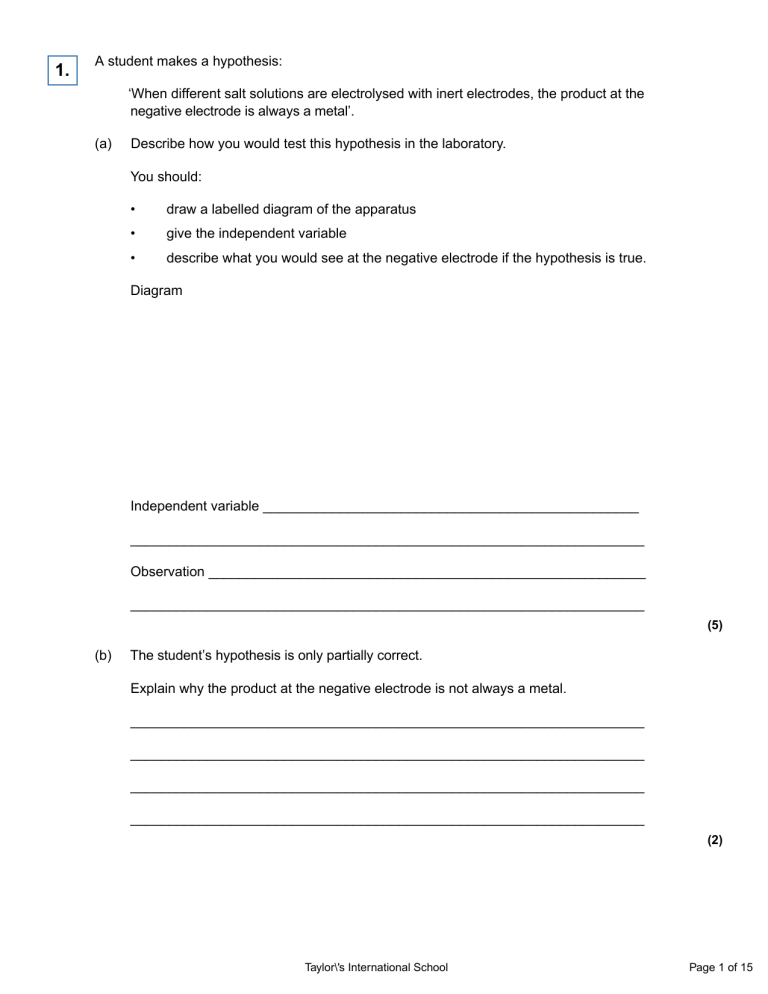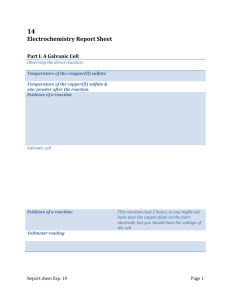
1. A student makes a hypothesis: ‘When different salt solutions are electrolysed with inert electrodes, the product at the negative electrode is always a metal’. (a) Describe how you would test this hypothesis in the laboratory. You should: • draw a labelled diagram of the apparatus • give the independent variable • describe what you would see at the negative electrode if the hypothesis is true. Diagram Independent variable _________________________________________________ ___________________________________________________________________ Observation _________________________________________________________ ___________________________________________________________________ (5) (b) The student’s hypothesis is only partially correct. Explain why the product at the negative electrode is not always a metal. ___________________________________________________________________ ___________________________________________________________________ ___________________________________________________________________ ___________________________________________________________________ (2) Taylor\'s International School Page 1 of 15 (c) Predict the product at the positive electrode in the electrolysis of: • sodium chloride solution • copper sulfate solution. Sodium chloride solution _______________________________________________ Copper sulfate solution ________________________________________________ (2) (Total 9 marks) 2. An investigation into the electrolyte copper sulphate solution was carried out as shown. (a) What does electrolyte mean? ___________________________________________________________________ ___________________________________________________________________ ___________________________________________________________________ (2) (b) These were the observations. (i) Negative electrode solid formed Positive electrode gas given off Name the solid formed. ______________________________________________________________ (1) (ii) Name the gas given off. ______________________________________________________________ (1) Taylor\'s International School Page 2 of 15 (c) How could a sample of gas be collected at the positive electrode? ___________________________________________________________________ ___________________________________________________________________ (2) (d) Suggest why the blue colour of copper sulphate becomes paler during the investigation. ___________________________________________________________________ ___________________________________________________________________ (2) (Total 8 marks) 3. The diagram shows apparatus used by a student to investigate electrolysis. The student was given a solution by the teacher. The solution contained a mixture of ionic compounds. (a) Name the particles which carry the electric current through: (i) the metal wires _________________________________________________ (1) (ii) the solution. ____________________________________________________ (1) Taylor\'s International School Page 3 of 15 (b) The table shows the ions in the solution. Positive ions in the solution Negative ions in the solution Zinc ion (Zn2+) Chloride ion (Cl–) Iron(III) ion (Fe3+) Hydroxide ion (OH–) Hydrogen ion (H+) Nitrate ion (NO3–) Copper(II) ion (Cu2+) Sulfate ion (SO42–) The reactivity series on the Data Sheet may help you to answer this question. (i) Which element is most likely to be formed at the negative electrode? ______________________________________________________________ (1) (ii) Explain, as fully as you can, why you have chosen this element. ______________________________________________________________ ______________________________________________________________ ______________________________________________________________ ______________________________________________________________ (2) (c) The electrolysis of sodium chloride solution is an industrial process. (i) The reaction at one of the electrodes can be represented by the equation shown below. 2Cl– → Cl2 + 2e– The chloride ions (Cl–) are oxidised. Explain why. ______________________________________________________________ ______________________________________________________________ (1) Taylor\'s International School Page 4 of 15 (ii) The reaction at the other electrode can be represented by an equation. Complete and balance the equation for the reaction at the other electrode. H+ → H2 (1) (Total 7 marks) 4. Electroplating is used to coat a cheap metal with a thin layer of an expensive metal. In the diagram a teaspoon made of nickel is being coated with silver. Silver nitrate (AgNO3) contains silver ions (Ag+) and nitrate ions (NO3−). (a) Solid silver nitrate, AgNO3(s), does not conduct electricity. Choose the correct answer in the box to complete the sentence. are too big cannot move are too small Solid silver nitrate does not conduct electricity because the ions _______________ ___________________________________________________________________ (1) Taylor\'s International School Page 5 of 15 (b) Draw a ring around the correct answer to complete each sentence. (i) Silver ions move to the negative electrode because no charge. they have a negative charge. a positive charge. (1) atoms. (ii) When silver ions reach the negative electrode they turn into silver compounds. molecules. (1) (Total 3 marks) 5. The electrolysis of sodium chloride solution is an industrial process. (a) Why do chloride ions move to the positive electrode? ___________________________________________________________________ (1) Taylor\'s International School Page 6 of 15 (b) Sodium chloride solution contains two types of positive ions, sodium ions (Na+) and hydrogen ions (H+). Tick ( ) the reason why hydrogen is produced at the negative electrode and not sodium. Reason Tick ( ) Hydrogen is a gas. Hydrogen is less reactive than sodium. Hydrogen is a non-metal. Hydrogen ions travel faster than sodium ions. (1) (c) Solution X is alkaline. Which ion makes solution X alkaline? ___________________________________________________________________ (1) (d) Electrolysis of sodium chloride solution produces hydrogen and chlorine. The hydrogen and chlorine can be used to make hydrogen chloride. (i) The diagrams show how the outer electrons are arranged in atoms of hydrogen and chlorine. Complete the diagram to show how the electrons are arranged in a molecule of hydrogen chloride (HCl). (1) Taylor\'s International School Page 7 of 15 (ii) Name the type of bond between the hydrogen and the chlorine atoms in a molecule of hydrogen chloride. ________________________________________ (1) (iii) Some hydrogen chloride was bubbled into water. This made a solution with a pH of 1. Which ion gave the solution a pH of 1? ________________________________________ (1) (Total 6 marks) 6. This question is about potassium. (a) Humphrey Davy was a professor of chemistry. In 1807 Davy did an electrolysis experiment to produce potassium. (i) Davy first tried to electrolyse a solid potassium salt to produce potassium. Explain why this electrolysis did not work. ______________________________________________________________ ______________________________________________________________ ______________________________________________________________ ______________________________________________________________ (2) (ii) Humphrey Davy was the first person to produce potassium. Humphrey Davy’s experiment to produce this new element was quickly accepted by other scientists. Suggest why. ______________________________________________________________ ______________________________________________________________ (1) Taylor\'s International School Page 8 of 15 (b) A student dissolved some potassium chloride in water. The student tried to electrolyse the potassium chloride solution to produce potassium. The apparatus the student used is shown in the diagram. The student expected to see potassium metal at the negative electrode, but instead saw bubbles of a gas. • Name the gas produced at the negative electrode. • Explain why this gas was produced at the negative electrode and why potassium was not produced. The reactivity series of metals on the Chemistry Data Sheet may help you to answer this question. ___________________________________________________________________ ___________________________________________________________________ ___________________________________________________________________ ___________________________________________________________________ ___________________________________________________________________ ___________________________________________________________________ (3) (c) The student tried to electrolyse molten potassium chloride to produce potassium. (i) Potassium metal was produced at the negative electrode. Describe how potassium atoms are formed from potassium ions. ______________________________________________________________ ______________________________________________________________ ______________________________________________________________ ______________________________________________________________ (2) Taylor\'s International School Page 9 of 15 (ii) Complete and balance the equation for the reaction at the positive electrode. ______Cl− Cl2 + __________ (1) (iii) Complete the diagram to show the electronic structure of a chloride ion (Cl−). (1) (Total 10 marks) Taylor\'s International School Page 10 of 15





